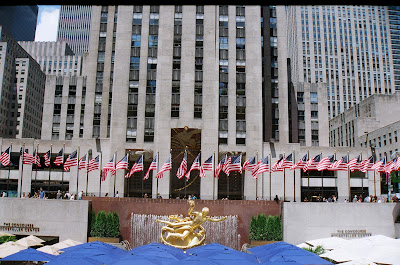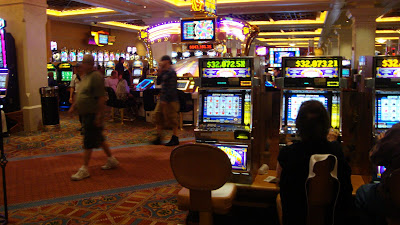New Orleans is awesome. Totally awesome. It is, without doubt, the best city we have encountered so far in the States, including New York. And that's saying something.
The funny thing is, it doesn't really feel American. It has its own indomitable spirit, and draws heavily from its Cajun, French and Spanish heritage. You won't see many stars-and-stripes down here, but you'll see the Fleur-de-Lys liberally plastered on almost everything. The cuisine is totally different from the rest of the United States, and the whole city (and indeed the state) has a deeply festive atmosphere, not just during Mardi Gras, that the surrounding states such as Alabama and Mississippi, don't seem to have as much of.
So on the first night it was hardly surprising that we found ourselves holed up in a restaurant just off Bourbon St., with a bowl of Gumbo and fried alligator in front of us and two pints of the 'local brew' in our hands. After supping, we took a wander around the French Quarter. In the day, this historic district is full of restaurants selling Cajun and Creole food, quaint museums and fantastic cafes. At night, the place comes alive. Bourbon Street especially. Neon signs burn your irises as you walk down row after row of late-night bars, seedy strip clubs and dive eateries. Live music blares out of every venue: usually jazz, blues or rock. Bar employees stand outside beckoning to people to enter: cover charges seem not to exist here (thank god), and bouncers put up only a token resistance if you're under 21. Far from marking your hands and practically segregating you as they do in New York and other places, you are usually waved inside with a fleeting "ok, you're not allowed to drink, right?". Nobody asks any questions on the inside, and there's nothing to differentiate you from the other punters. Its nightlife feels very similar to that in some of Europe's party centers: think Ibiza, Agia Napa or the Greek Islands of Ios or Mykonos. Advice for future travelers: definitely go through Bourbon St for the experience, but to get a better sense of the local flavor head down to Frenchmen St (only a 5 min walk from Bourbon) and check out the jazz bars and hole-in-the-walls. There are always live acts at the bars there that locals and musicians alike flock to at night.
Needless to say Dex spent the next two hours with a numb tongue, stomach ache and headache. On the 'Scoville' scale of pepper heat, the 'Ghost' pepper has about 800,000 to 1,400,000 units. A jalapeño has about 5,000, and Tabasco about 50,000. That says it all, really. To soothe our numb mouths we sat down at the first established cafe in NOLA (Cafe du Monde) and enjoyed a much-needed cafe au lait and some beignettes, so-called French doughnuts with powdered sugar on top.
Later that afternoon we took the antique St. Charles streetcar into the Garden district, and to the districts to the west of the French Quarter. We saw some stunning 'Southern mansions', and got a feel for public transportation in the Big Easy circa A Steetcar Named Desire era.
New Orleans food is pretty interesting. It all seems to be some form of seafood broth served with rice. Gumbo, the classic, is filling and tastes fantastic. Jambalaya and red beans n' rice are ok, but nothing quite beats étouffée dishes, specifically with shrimp or crawfish. Crawfish étouffée is highly recommended. There is also a lot of alligator on offer, which tastes like tough chicken with a slight seafood flavor.
New Orleans is also situated in a rather unique environment. It is caught between a lake and a river, themselves situated in a huge bayou. We ventured into this bayou on Tuesday, when we went for an swamp tour! We highly recommend it to anyone who finds themselves in NOLA. We were taken through the swamps and saw birds, turtles, and of course.. Alligators!! We have quite a few photos from the tour (see below). The tour also took us to a Cajun village (the residents are known as 'the swamp people'), and learned about their past and present way of life. Quite a few residents are new and reconstructed their own swamp homes after Hurricane Katrina, which completely destroyed the majority of the homes. Interestingly, a few of the homes sported Confederate flags...
The funny thing is, it doesn't really feel American. It has its own indomitable spirit, and draws heavily from its Cajun, French and Spanish heritage. You won't see many stars-and-stripes down here, but you'll see the Fleur-de-Lys liberally plastered on almost everything. The cuisine is totally different from the rest of the United States, and the whole city (and indeed the state) has a deeply festive atmosphere, not just during Mardi Gras, that the surrounding states such as Alabama and Mississippi, don't seem to have as much of.
Shop signs and verandas in the French Quarter
Part of the reason it is so fantastic is that it's rather liberal when it comes to alcohol consumption. Any supermarket or cornershop is allowed to sell it; one is allowed to drink in the street (plastic cups only); and while the drinking age is 21 like the rest of the States, most establishments are somewhat relaxed, far more so than they are in the Northeast, say.Bourbon St at night, photo not our own
So on the first night it was hardly surprising that we found ourselves holed up in a restaurant just off Bourbon St., with a bowl of Gumbo and fried alligator in front of us and two pints of the 'local brew' in our hands. After supping, we took a wander around the French Quarter. In the day, this historic district is full of restaurants selling Cajun and Creole food, quaint museums and fantastic cafes. At night, the place comes alive. Bourbon Street especially. Neon signs burn your irises as you walk down row after row of late-night bars, seedy strip clubs and dive eateries. Live music blares out of every venue: usually jazz, blues or rock. Bar employees stand outside beckoning to people to enter: cover charges seem not to exist here (thank god), and bouncers put up only a token resistance if you're under 21. Far from marking your hands and practically segregating you as they do in New York and other places, you are usually waved inside with a fleeting "ok, you're not allowed to drink, right?". Nobody asks any questions on the inside, and there's nothing to differentiate you from the other punters. Its nightlife feels very similar to that in some of Europe's party centers: think Ibiza, Agia Napa or the Greek Islands of Ios or Mykonos. Advice for future travelers: definitely go through Bourbon St for the experience, but to get a better sense of the local flavor head down to Frenchmen St (only a 5 min walk from Bourbon) and check out the jazz bars and hole-in-the-walls. There are always live acts at the bars there that locals and musicians alike flock to at night.
The infamous Bourbon St., in the daytime.
It isn't just a party town, of course. New Orleans is steeped in culture, by virtue of its multinational heritage. On Monday, a walk around the French quarter in the day yielded views of beautiful French and Spanish architecture, narrow streets and the intriguing sensation of walking 'up' to the river. We perused the daily Farmer's Market, which sells all sorts of interesting foodstuffs, and made the mistake of sampling some Ghost Pepper sauce (apparently the strongest pepper in the world).
Outside of the French Market
The real thing: N'awlins Ghost Pepper Sauce
Needless to say Dex spent the next two hours with a numb tongue, stomach ache and headache. On the 'Scoville' scale of pepper heat, the 'Ghost' pepper has about 800,000 to 1,400,000 units. A jalapeño has about 5,000, and Tabasco about 50,000. That says it all, really. To soothe our numb mouths we sat down at the first established cafe in NOLA (Cafe du Monde) and enjoyed a much-needed cafe au lait and some beignettes, so-called French doughnuts with powdered sugar on top.
Dex with the Cafe du Monde goodies
Later that afternoon we took the antique St. Charles streetcar into the Garden district, and to the districts to the west of the French Quarter. We saw some stunning 'Southern mansions', and got a feel for public transportation in the Big Easy circa A Steetcar Named Desire era.
St. Chaaaaaarles Streetcar
New Orleans food is pretty interesting. It all seems to be some form of seafood broth served with rice. Gumbo, the classic, is filling and tastes fantastic. Jambalaya and red beans n' rice are ok, but nothing quite beats étouffée dishes, specifically with shrimp or crawfish. Crawfish étouffée is highly recommended. There is also a lot of alligator on offer, which tastes like tough chicken with a slight seafood flavor.
New Orleans is also situated in a rather unique environment. It is caught between a lake and a river, themselves situated in a huge bayou. We ventured into this bayou on Tuesday, when we went for an swamp tour! We highly recommend it to anyone who finds themselves in NOLA. We were taken through the swamps and saw birds, turtles, and of course.. Alligators!! We have quite a few photos from the tour (see below). The tour also took us to a Cajun village (the residents are known as 'the swamp people'), and learned about their past and present way of life. Quite a few residents are new and reconstructed their own swamp homes after Hurricane Katrina, which completely destroyed the majority of the homes. Interestingly, a few of the homes sported Confederate flags...
The Bayou
Maryann with a baby gator, d'aw
An, erm, much bigger alligator, nicknamed 'Cindy'
Swamp People, don't mess
It's shocking to see how the devastating effects of Hurricane Katrina are still felt throughout the Big Easy. As we drove to the bayou, our driver pointed out the 9th ward, one of the areas most affected by the storm, where most of the homes were still destroyed. In other areas, just this year have businesses reopened their stores in the lower levels that couldn't weather the storm as well as the historic districts (which are situated much higher above sea-level). In the 6 years since the storm hit, thousands of previous New Orleans residents are still living in temporary accommodations in Louisiana and Mississippi. Needless to say, while the Big Easy soldiers on with life, Hurricane Katrina has definitely cast a shadow that will take time to pass.





































